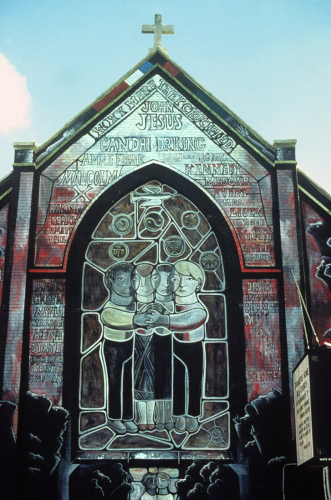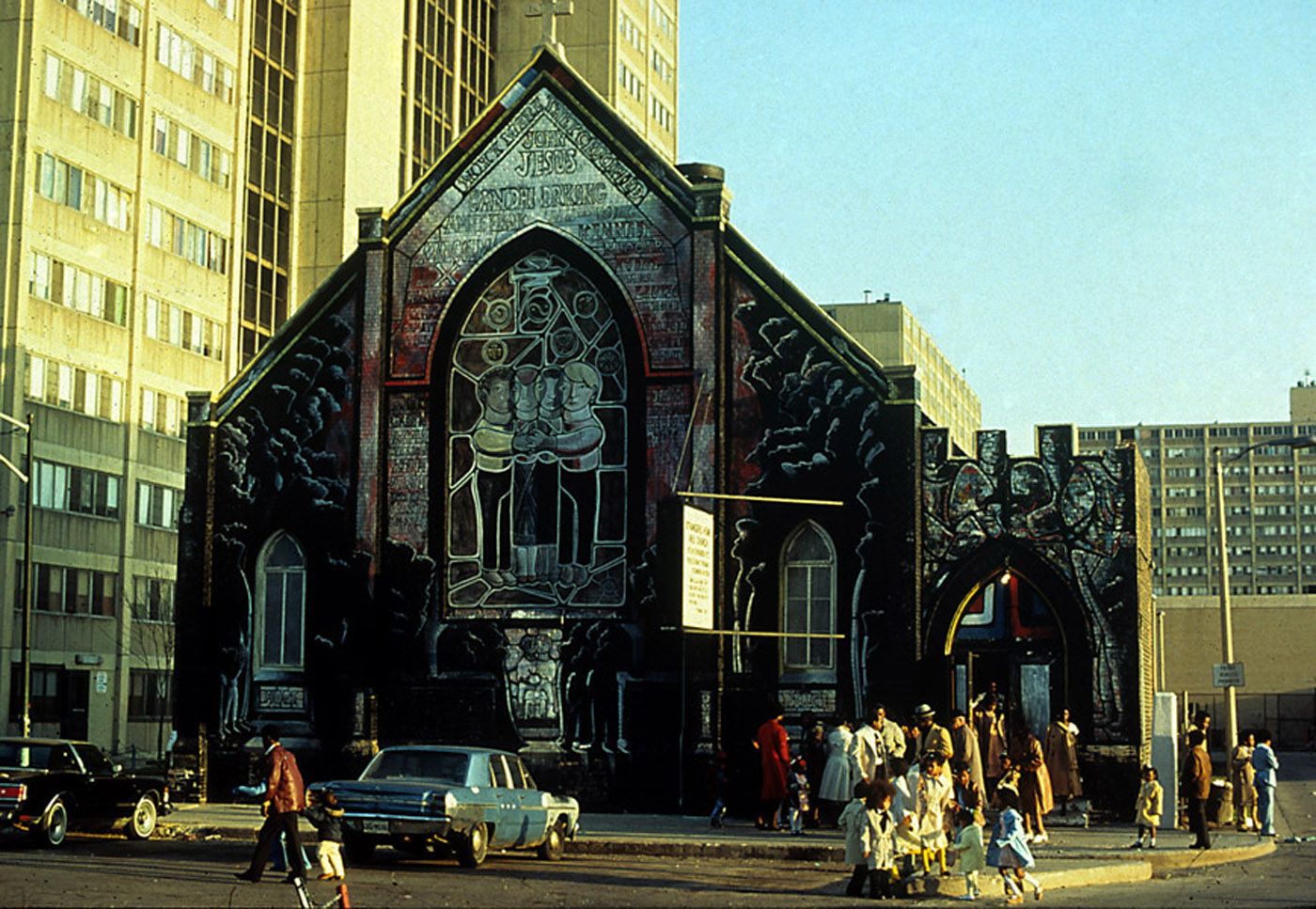The Northside Stranger’s Home Missionary Baptist Church stands alone on the field of grass where the Cabrini-Green public housing complex once stood. Located at the intersection of Clybourn Avenue and Larrabee Street, the church is a brick building whose architectural style sets it apart from other less dated buildings in the vicinity. But what is most noticeable is the gaping emptiness of the white facade. Any passerby can tell that something is missing.
On that wall, until December of 2015, there used to be a mural entitled “All of Mankind.” In the mural, four people of different genders and ethnicities stood abreast, clutching each other’s hands. Most strikingly, the four individuals shared five eyes, each individual’s face interlocking with the faces next to it. They were standing in front of a painted stained-glass window that bore symbols of various religions, while a dove flew overhead. Under the cross on the roof of the church, the mural asked, “Why were they crucified?” Names like Jesus, Dr. King, Kennedy, and Hampton were inscribed on the wall, along with groups like Jews in Nazi Germany and incidents like Kent State and My Lai. At the base of the mural, a little higher than eye level, was a crowd of silhouettes gazing somberly at the four individuals and the list of names.
When William Walker painted this mural in 1972, the building housed a Catholic church called San Marcello Mission. Recognized as the father of the community mural movement, Walker was a prominent member of the Organization for Black American Culture (OBAC) and cofounder of the Chicago Mural Group, now known as the Chicago Public Art Group (CPAG). Among his most famous works was his contribution to the “Wall of Respect”, painted at Langley Avenue and 43rd Street, alongside other artists from the OBAC in 1967. Many sections were painted as a response to the Civil Rights Movement, attesting to the mural’s historical significance. Unfortunately, this piece of history was obliterated when a building fire destroyed the mural in 1971. Jon Pounds, the Executive Director Emeritus of the CPAG, highlighted the significance of “Wall of Respect” in the history of the community mural movement in Chicago, saying, “It would be today what we would consider a social happening, with poets, musicians, and artists converging on a site for the visual artists who are painting directly out of doors, and making this really positive statement about African American culture. This was certainly a moment when African American artists established a vision for what artists might communicate.”
The comparable historic significance of “All of Mankind” is heightened by its proximity to Cabrini-Green. Pounds explained the poignancy of the mural’s spatial and temporal context. “The mural that Bill did in ’72 was quite outside what our social and cultural thinking was at that time,” he says. “That was a time of separation and pride in our differentness. It was a time when the individual was of primary importance, as determined by their identity. And what Bill’s piece did in “All of Mankind” was to link us all in a way that now we have a slight consciousness of, but we have not accomplished.”

The importance of “All of Mankind” is inextricably linked to the history of Cabrini-Green. During Richard M. Daley’s fourth term as mayor, the Chicago Housing Authority initiated its ten-year Plan for Transformation. Bounded by wealthy, largely white neighborhoods like Lincoln Park and River North, Cabrini-Green had always been, to municipal officials and residents of adjacent neighborhoods, the eyesore of the Near North Side. With the last apartment building demolished in 2011, it was only a matter of time before the church changed hands. Already, in 2004, a separate mural by Walker in the church’s interior was whitewashed, despite the CPAG advocating for its restoration. In the fall of 2015, the owners of the church, the family of Rev. Dempsey Thomas, found a buyer for $999,900, according to the Chicago Reader. Pounds mentioned that the owners of the church believed that the mural would have complicated the sale, so they decided to have it whitewashed without further discussion. “All of Mankind” was the last of three William Walker murals around the Cabrini-Green neighborhood.
Lee Bey, an architecture critic and writer, was a member of the All of Mankind Coalition. The coalition, of which Pounds was also a member, advocated for the preservation and restoration of the mural for years, and included architects, artists, and writers. Bey expressed regret at the destruction of Walker’s work. “I think it’s terrible. I think in this city, we are currently running the risk of losing things that speak to the black experience in this city, particularly during those times in the sixties and the seventies when African Americans were emerging from horrible conditions in the South, finding hope in the city, and establishing identity through culture and art.”
“And for a William Walker mural,” added Bey, “the father of this movement, for one of his significant works to be wiped away…This would be like a Frank Lloyd Wright building being just wrecked for a parking lot. It’s of that import. In other parts of the city, his murals are being restored, so his work isn’t totally lost. But this one, given where it is, given the message, this one needed to be saved.”
According to Pound, the whitewashing of “All of Mankind” happened due to pressures from private actors. Pounds stated, “It seems like such a short-sighted and cash-driven decision that lacked a spiritual or social conscience.” Nonetheless, the 27th Ward Alderman Walter Burnett, Jr., himself raised in Cabrini-Green, advocated for the restoration of “All of Mankind.”
“[Burnett] was really concerned about this, talked about it, and entertained dialogue about saving it, but the city’s hands are tied in many ways in this,” said Bey. “You don’t need a permit for this kind of thing, there’s no permit to deny. Even if there was, the grounds would be specious.”
Murals as an art form are not meant to last in perpetuity. “Muralists don’t think their projects are going to last forever,” says Pounds. For him, however, whitewashing a mural is never a defensible act: “I don’t think painting it over is an appropriate thing to do any time, because all that does is adding a layer of paint, which is blank, to the surface that had some meaning on it,” he explained.
Despite the whitewashing of “All of Mankind,” other murals of Walker’s remain, mostly on the South Side. “Childhood is Without Prejudice,” for instance, is a similarly styled mural of four children of different ethnicities sharing eyes and embracing each other; it’s located at 56th Street and Stony Island Avenue. Despite the cultural loss of whitewashing, Pounds emphasized that it was important to consider the issues “All of Mankind” brought up, especially the mural’s call for mutual understanding. “We can no longer stand in front of a sixty-foot tall mural and consider the scale and the visual impact of having this in our field of vision,” he said. “But we’re not done with the issues that were in that mural. We’re not done and resolved with them at all, but at this moment, all we can do is look at photographs of them.”
Since the establishment of Walker’s Chicago Mural Group, murals have enriched public life in Chicago, but the future of public art in the city is in question. “I think the larger issue is that we, as a society, have to decide how we’re going to be vigilant about such acts, and maybe a lot can be changed,” said Bey. “But I think that really, it comes down to people caring about the stories that these murals tell. And I think that’s not the case.” ¬


This is a fascinating piece of history. I drive by the church often and wondered Its seemingly burned out and blackened exterior makes it feel mysterious and somewhat foreboding. No signage, no plaque no historical marker. This is an important and teachable piece of history. It should be shared with schools, artists and community leaders. These days it’s likely to gain traction and renovation. One might call this “black washing” as well as “white washing!”